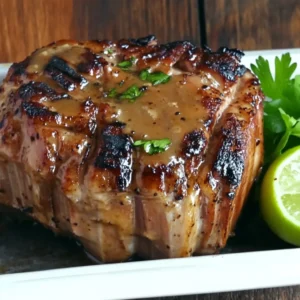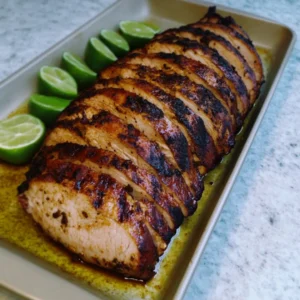Cuban Mojo Pork is an iconic Cuban dish renowned for its tender texture, savory depth, and bright citrusy notes. It has roots deeply planted in Cuban culture and has spread far beyond the island, captivating food lovers around the globe. This dish typically involves marinating pork in mojo sauce, which combines fresh garlic, sour orange juice, and herbs, and then slow-cooking it until the pork is melt-in-your-mouth tender. The contrast between the savory pork and the zesty, tangy marinade is what makes Cuban Mojo Pork unforgettable.
The Origins and Significance of Cuban Mojo Pork
Cuban Mojo Pork isn’t just a dish—it’s a symbol of Cuban heritage. At the heart of this beloved meal is mojo sauce, a flavorful marinade that has been used in Cuban kitchens for centuries. The word “mojo” is derived from the Canarian word “mójito,” which refers to a sauce or marinade, and it arrived in Cuba with Spanish settlers. Over time, this marinade became central to Cuban cuisine, particularly when paired with pork, as it helps balance the richness of the meat.
Mojo sauce, typically composed of garlic, citrus juices, and herbs, is key to creating that signature flavor of Cuban Mojo Pork. One of the defining ingredients is sour orange juice, which imparts a tart and slightly bitter edge that brightens the pork’s natural flavors. While sour oranges are difficult to find outside of Cuba, many cooks turn to a blend of orange and lime juices as a substitute to replicate the signature taste (source).
If you’re looking for a detailed recipe to try Cuban Mojo Pork, this one from Serious Eats offers great insight into the classic slow-roasted method, ensuring your pork comes out perfectly tender and juicy.
Why is Mojo Pork So Popular?
The reason mojo pork is so popular is due to the perfect balance of flavors it offers. The richness of the pork contrasts beautifully with the bright acidity and slight bitterness of the mojo sauce. What makes the marinade even more exceptional is the garlic, cumin, and oregano that bring out deep, earthy undertones. Whether you’re enjoying it in a festive Cuban gathering or as a casual dinner, Cuban Mojo Pork hits all the right notes.
For an even deeper look into the origins and recipe variations, check out Wikipedia’s entry on Mojo Sauce.
The Essential Ingredients in Mojo Pork
To create the perfect Cuban Mojo Pork, it’s crucial to use the right combination of ingredients. The mojo marinade is the heart of this dish, and while the core components remain the same, there are slight variations depending on regional tastes. Here are the ingredients you’ll need:
-
Pork Shoulder or Pork Butt – The best cuts for slow-cooking and roasting.
-
Fresh Garlic – This will give the mojo sauce its punch.
-
Sour Orange Juice – The signature acidic flavor of the sauce (or a mix of orange and lime juice if sour oranges aren’t available).
-
Fresh Oregano and Cilantro – Key herbs for flavoring the marinade.
-
Cumin – A spice that adds warmth and depth to the sauce.
-
Bay Leaves – For a slightly floral, earthy flavor.
-
Olive Oil and Salt – To bring everything together and balance the acidity.
These ingredients come together to create a mojo marinade that coats the pork and infuses it with rich, tangy flavors. The fresh garlic and citrus juices dominate the flavor profile, while the cumin and oregano add complexity and balance. If you want to learn more about the specific types of pork cuts for Mojo Pork, this guide from Serious Eats will give you valuable tips.
The Importance of Fresh Ingredients
As with any dish, the quality of the ingredients plays a huge role in the final product. For the best results, use fresh garlic and citrus—they provide the necessary zing and brightness that frozen or bottled alternatives can’t match. You also want to ensure that your pork is fresh and of good quality, as the slow-cooking process will allow the flavors to develop and permeate the meat.
The sour orange juice can be difficult to find outside of Cuba, but it’s essential to the authenticity of the dish. If you’re in a pinch, a combination of equal parts orange and lime juice can serve as a suitable replacement.
How to Prepare Cuban Mojo Pork

Selecting the Right Cut of Pork
The choice of pork cut is essential in achieving the perfect Cuban Mojo Pork. The traditional cuts used are pork shoulder and pork butt. These cuts are well-marbled with fat, which helps keep the meat tender and juicy when slow-cooked. As the pork cooks, the fat renders and creates a succulent, melt-in-your-mouth texture.
You can also experiment with other cuts of pork, but the ones mentioned above are the best for this recipe. While pork tenderloin is leaner, it won’t provide the same level of juiciness. When shopping, look for cuts that have a good amount of marbling—this fat will help the pork stay tender while absorbing the flavors of the mojo sauce.
Preparing the Mojo Marinade
The mojo marinade is where the magic happens. The key to a flavorful Cuban Mojo Pork lies in how well the pork is marinated. Follow these steps for preparing the marinade:
-
Step 1: Peel and crush several cloves of fresh garlic in a mortar and pestle or food processor.
-
Step 2: Add cumin, oregano, bay leaves, and cilantro to the garlic mixture.
-
Step 3: Pour in the sour orange juice (or a mix of orange and lime juice) and about ¼ cup of olive oil. Season with salt to taste.
-
Step 4: Blend the mixture into a smooth marinade.
Once the marinade is prepared, it’s time to coat the pork. Pour the marinade over the pork and rub it in thoroughly to ensure every inch of the meat is covered.
Marinating the Pork
The marinating process is key to achieving the full flavor of Cuban Mojo Pork. For the best results, let the pork marinate for at least 6 hours, though overnight is ideal. The longer the pork marinates, the deeper the flavor will penetrate the meat. Be sure to refrigerate the pork while it marinates to keep it fresh.
It’s also important to turn the pork halfway through marinating to ensure that all sides get equal exposure to the marinade.
Cooking Cuban Mojo Pork
Roasting in the Oven
One of the most traditional methods for cooking Mojo Pork is slow-roasting it in the oven. Preheat your oven to 300°F (150°C). Place the marinated pork in a roasting pan and cook it for approximately 3 to 4 hours, depending on the size of your pork cut. The key to roasting is patience—let the pork cook low and slow to break down the collagen in the meat, which will result in a tender roast that can be easily shredded.
The slow roasting method allows the pork to develop a crispy, caramelized exterior while maintaining its juicy interior.
Slow-Cooking Mojo Pork
If you’re looking for a more hands-off approach, you can prepare Mojo Pork in a slow cooker. Simply place the marinated pork in the slow cooker and cook on low for 6 to 8 hours. This method is particularly convenient for busy days when you don’t have time to babysit the oven. The result is still tender, juicy pork with the same deep flavor from the mojo marinade.
Instant Pot Mojo Pork
For a quicker cooking method, try using an Instant Pot. Pressure cooking the pork in the Instant Pot will significantly reduce the cooking time. Set the Instant Pot to high pressure for 60 minutes and let it naturally release the pressure once the cooking time is up. This method will give you the same tender, juicy pork but in a fraction of the time.
Serving Cuban Mojo Pork
Cuban Mojo Pork is often served with traditional Cuban sides, including:
-
White rice – The perfect base to soak up the flavors of the pork and mojo sauce.
-
Black beans – A staple of Cuban cuisine that pairs perfectly with the richness of the pork.
-
Fried plantains – Sweet, crispy plantains provide a delightful contrast to the savory pork.
-
Cuban bread – Serve Mojo Pork as a sandwich for a Cuban twist on the classic pulled pork.
Additionally, you can get creative with your serving style. Mojo Pork also works well in tacos, wraps, and salads. You can even serve it as a filling for Cuban sandwiches, topped with pickles, mustard, and Swiss cheese.
Variations of Cuban Mojo Pork
While the traditional recipe is loved by many, there are also creative ways to adapt this dish to suit different tastes. For instance, some regions of Cuba add sweet peppers or even pineapple to the marinade for added sweetness and depth.
Additionally, if you’re following a gluten-free or low-carb diet, Mojo Pork can easily be served on its own with a side of vegetables or cauliflower rice for a healthier twist.
If you’re looking for a simplified version, you can even prepare a Mojo Pork stir-fry by cutting the pork into bite-sized pieces and quickly cooking them in a hot pan with some of the mojo marinade.
Storing and Reheating Leftovers

If you have leftovers, don’t worry—they taste even better the next day! Store your leftover Cuban Mojo Pork in an airtight container in the refrigerator for up to 3 days. When reheating, you can use a skillet or the oven to warm the pork. Be sure to add a little water or broth to keep the pork moist as it reheats.
For longer storage, you can freeze the Mojo Pork. Simply let it cool completely, portion it out, and store it in freezer-safe bags or containers. Frozen Mojo Pork can last up to 3 months.
FAQs About Cuban Mojo Pork
1. Can I use chicken instead of pork for Mojo?
Yes, you can use chicken or other meats, but pork is the traditional choice. The mojo sauce works wonderfully with different proteins, so feel free to experiment with your preferred meat.
2. How do I make Mojo Pork spicier?
To add heat to the marinade, include jalapeños or habanero peppers. You can also sprinkle some cayenne pepper or red pepper flakes to enhance the spice level.
3. Can I make Cuban Mojo Pork without sour orange juice?
If you can’t find sour orange juice, you can substitute it with a blend of orange and lime juice in equal proportions. This mixture mimics the tartness of sour oranges.
Print
Cuban Mojo Pork
- Total Time: 4 hours 15 minutes
- Yield: 6 servings 1x
Description
A classic Cuban dish featuring tender, slow-cooked pork marinated in a flavorful citrus-garlic mojo sauce, perfect for any occasion.
Ingredients
- 4 lbs pork shoulder or pork butt
- 8 cloves garlic, minced
- 1 cup sour orange juice (or 1/2 cup orange juice + 1/2 cup lime juice)
- 1/4 cup olive oil
- 2 teaspoons cumin
- 2 teaspoons dried oregano
- 1 teaspoon salt
- 1 teaspoon black pepper
- 2 bay leaves
- 1/4 cup chopped fresh cilantro
Instructions
- In a bowl, mix garlic, sour orange juice, olive oil, cumin, oregano, salt, black pepper, bay leaves, and cilantro to create the mojo marinade.
- Place the pork shoulder in a large bowl or resealable bag and pour the marinade over it, ensuring the meat is fully coated.
- Marinate in the refrigerator for at least 6 hours, preferably overnight.
- Preheat the oven to 300°F (150°C).
- Place the marinated pork in a roasting pan and cover with foil.
- Roast for 3-4 hours, basting occasionally with the marinade, until the pork is fork-tender.
- For a crispy finish, uncover the pork and broil for the last 10 minutes.
- Let the pork rest for 10-15 minutes before shredding and serving.
Notes
For an alternative cooking method, cook the marinated pork in a slow cooker on low for 6-8 hours or in an Instant Pot on high pressure for 60 minutes.
- Prep Time: 15 minutes
- Cook Time: 4 hours
- Category: Main Course
- Method: Roasting
- Cuisine: Cuban
Nutrition
- Serving Size: 1 portion
- Calories: 450
- Sugar: 2g
- Sodium: 520mg
- Fat: 28g
- Saturated Fat: 10g
- Unsaturated Fat: 16g
- Trans Fat: 0g
- Carbohydrates: 4g
- Fiber: 1g
- Protein: 42g
- Cholesterol: 110mg
Keywords: mojo pork, Cuban pork, slow-cooked pork, citrus marinade

